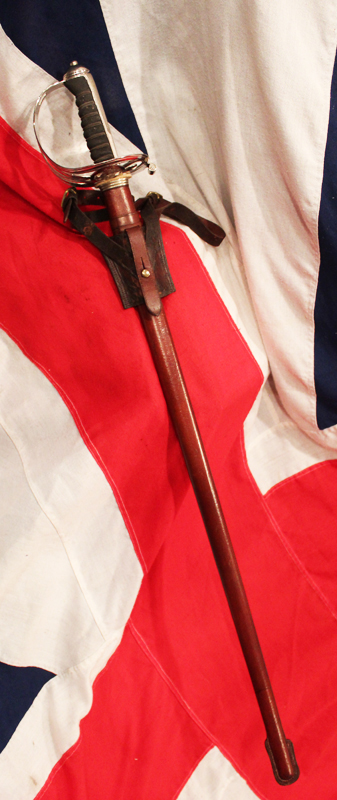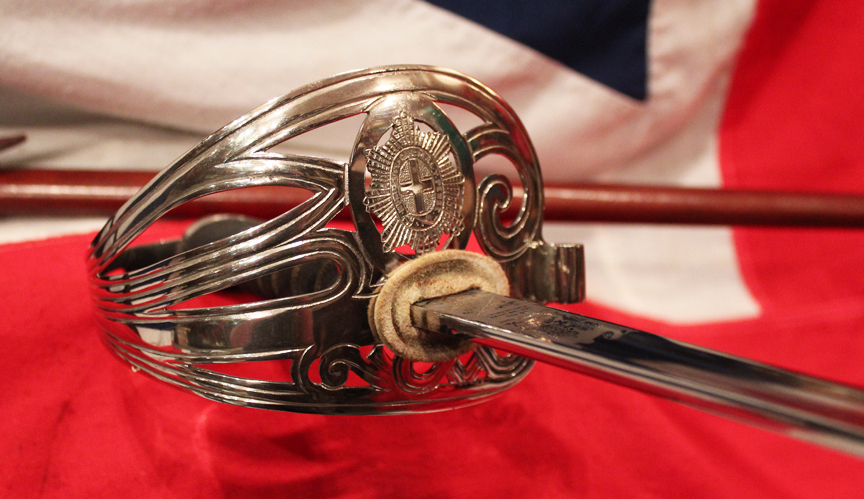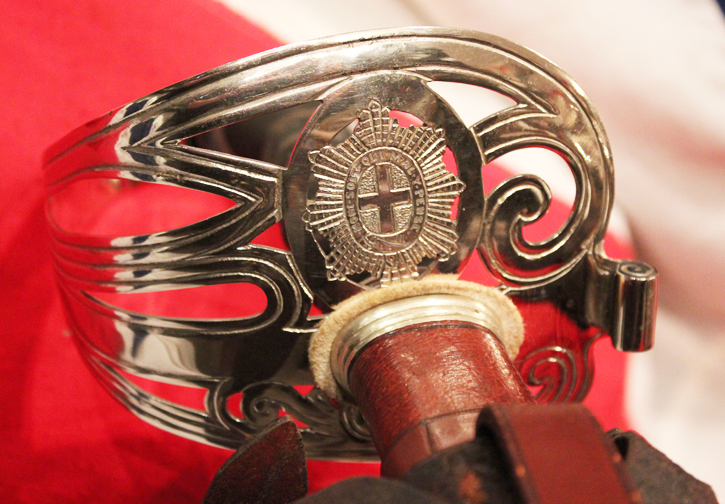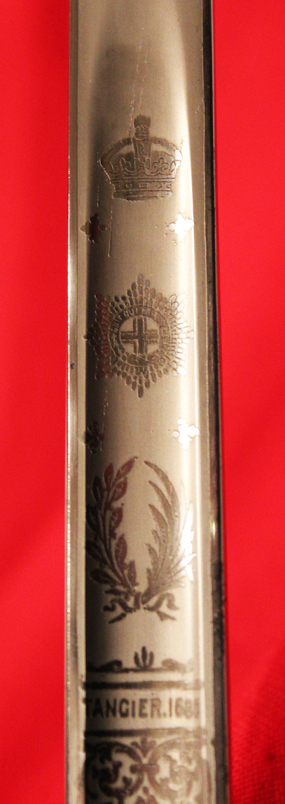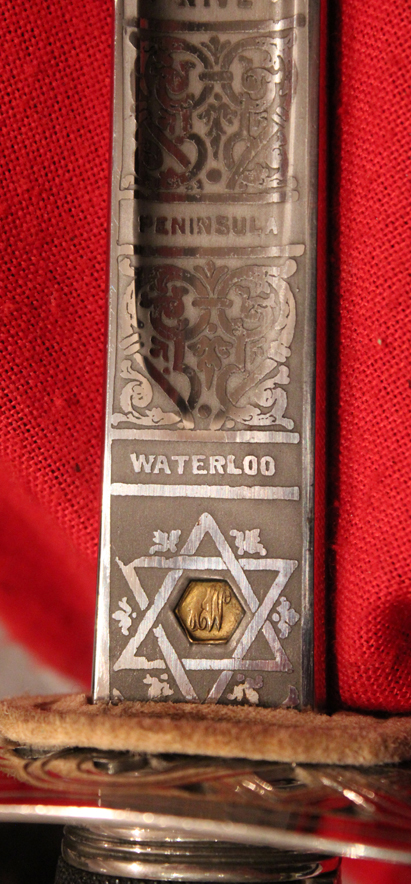A Near Mint Early WW2 Coldstream Guards 'Battle Honour' Wilkinson Officer's Sword of The Household Division, The King's Guard, With Fine FS Scabbard
An absolute historical beauty, from a WW2, British Expeditionary Force serving officer, with its original but worn frog. Commissioned from Wilkinson's by its owner in early-mid 1939. Deluxe grade with the regiment’s battle honours, up to 1918, in high grade etched detailing, within scrolls down the length of both sides of the blade, and GeorgeVIth Crown Cypher.
Near mint condition and perfectly serviceable for a serving officer today. The Coldstream Guards is an elite infantry regiment of the British Army. It is the most senior regiment of the Guards Division and, as such, is the most senior regiment of infantry. During the Second World War the regiment was expanded to six service battalions, with the re-raising of the 4th Battalion, and the establishment of the 5th and 6th Battalions. When the Second World War began, the 1st and 2nd battalions of The Coldstream Guards were part of the British Expeditionary Force (BEF) in France; whilst the 3rd Battalion was on overseas service in the Middle East. Additional 4th and 5th battalions were also formed for the duration of the war. They fought extensively, as part of the Guards Armoured Division, in North Africa and Europe as dismounted infantry. The 4th battalion first became a motorized battalion in 1940 and then an armoured battalion in 1943. the 1st Battalion, Coldstream Guards, and were part of the 3rd Infantry Division, led by Major General Bernard Law Montgomery. As the BEF was pushed back by the German blitzkrieg during the battles of France and Dunkirk, these battalions played a considerable role in maintaining the British Army's reputation during the withdrawal phase of the campaign before being themselves evacuated from Dunkirk. After this they returned to the United Kingdom where they undertook defensive duties in anticipation of a possible German invasion. They fought extensively in North Africa and Europe as dismounted infantry and the 1st battalion in the Guards Armoured Division. The 4th battalion first became a motorized battalion in 1940 and then an armoured battalion in 1943. The 4th and 5th served as part of the Guards Armoured Division. Landing in Normandy on 26 June 1944, the Guards were soon heading to the Caen region as part of VIII Corp, British Second Army, 21st Army Group. Caen, which was supposed to have fallen to the British on D-Day, still stood as a German stronghold. Caen was a key objective in the liberation of France as it was cantered on dry open plains bordered by Vimont to the east. Capturing Caen would be key to capturing Paris.
Operation Goodwood
The Guards, along with the 11th and 7th Armoured divisions endeavoured to take Caen through Operation Goodwood, which commenced 18 July 1944. The Guards were to penetrate German defences to the east of Caen, cut the Caen-Vimont road at Cagny and continue down to Vimont after an intense period of bombing. After Vimont, it was to join the assault on Bourgebus Ridge with the 11th and 7th Armoured to dig out the German defenders overlooking the city.
The aerial bombing was less effective than hoped on the first day. It missed many of the dug in defenders south of Caen and in Cagny and Emieville, east of Caen. These three defensive points were on the Guards? route and the fast attack that was intended bogged down.
Operation Goodwood
The Guards division alone lost 60 tanks to hidden 8.8cm AA guns of the 21. Panzerdivision around Cagny as well as the few remaining Tigers of the 503. Schwere Panzerabteilung near Emieville. Also, the advance of the three armoured divisions was hindered by a counter-attack by Kampfgruppe Hitlerjugend. Luckily, infantry losses were low and the losses in tanks were replaceable from the constant supply arriving on the beaches.
Guards Armoured Division infantry cross a wooden bridge
By 19 July, the Guards were able to carry on towards the Bourgebus Ridge to assist elements of the 11th and 7th Armoured in digging out the German defenders. However, the Germans held out throughout the operation, though not without losses. The outcome of Goodwood was somewhat in question with the British and Canadian divisions gaining ground, but many of the German defences remaining intact and quite effective. Caen fell within a few days. The real victory of Goodwood was it convinced the Germans that the major breakthrough attempts would be in and around Caen and not by the Americans in Operation Cobra. On 1 August, the Guards were called up to continue the rapid advance that the 11th Armoured had created against the two German infantry divisions (326. and 276.). The next two weeks would see intense bocage fighting as the Germans, reinforced with the 21. Panzer, 1., 9. and 10. SS-Panzerdivisions, fought for every mile of French ground. By 15 August, the German 7th Army began to withdraw only to be caught in the infamous Falaise Pocket. After their action in Normandy, the Guards went on to liberate Brussels. The British surprised the German garrison as the 5th Guards Armoured Brigade and the 32nd Guards Infantry Brigade advanced simultaneously into the capital, much to the delight of the locals. However, the ensuing celebration slowed the Guards advance and allowed many of the German units to retreat and regroup for the later defence along the Siegfried Line. The British 1st Airborne Division eventually withdrew from the Arnhem area having suffered roughly 8,000 casualties. The Guards Armoured Division came within a mile of reaching their lines, but was unable to push through the withering German defence.
The pressure that was exerted on not only their own line of advance, but also from all sides of the offensive, requiring them to help the American airborne hold their gains to the south.
The Guards Armoured Division saw additional action in early 1945 as they advanced into the German hinterland. Crossing the Rhine River, they found themselves assaulting the ‘Siegfriend Line’ with the 51st Highland Division. They then pushed on toward Lindel and Bremen under constant harassing attacks by the German 1st Parachute Army among others.
Late April saw many more attacks by the Germans as the defenders either surrendered or became more desperate in their counter-attacks. Finally, on 5 May, the German surrender was announced and the Guards went on to disarmament duties in Germany, giving up their tanks for good.
Code: 22816

